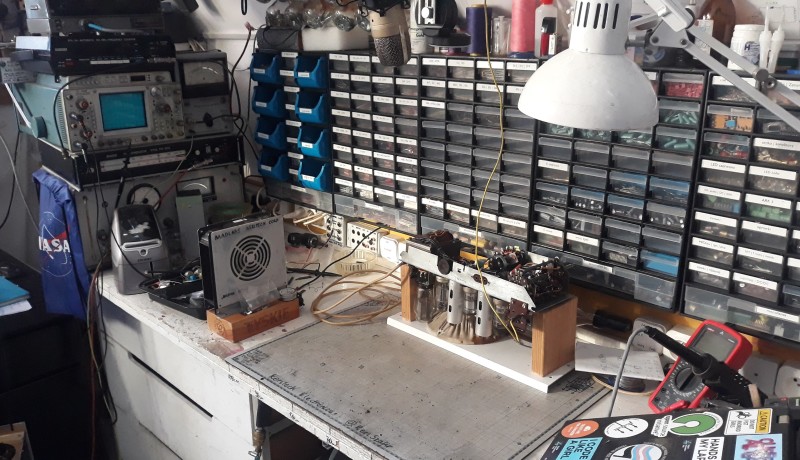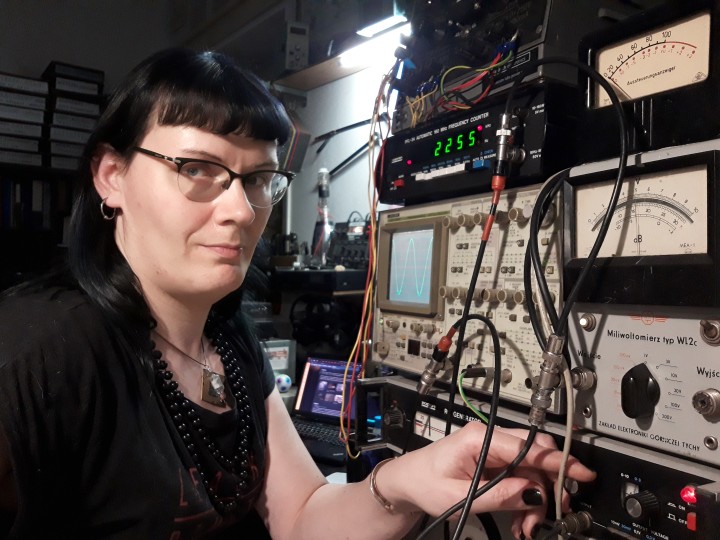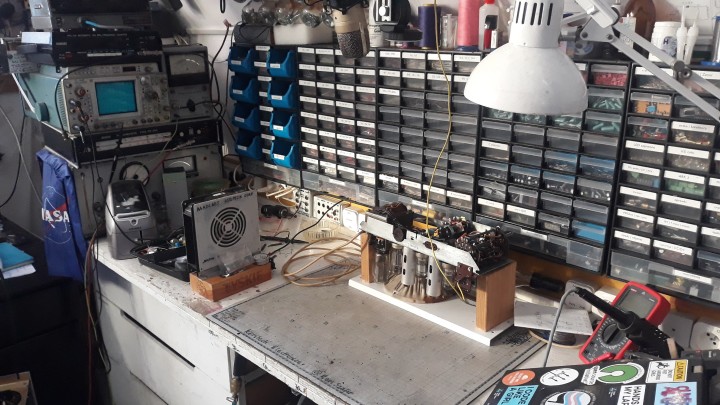Engineering on a Budget: An Electronics Workspace for Audio, Vintage Restorations, and More
December 25, 2023
on
on

Meet Keri Szafir, an electronics engineer from Gdańsk, Poland, and discover her unique electronics workspace, where she pursues her passion for audio, vintage restorations, and creative solutions. The space is proof that innovation doesn't always come with a hefty price tag!
What do you do for work?Keri Szafir: I am an electronics engineer in the R&D department of an EV charging station manufacturing company and have been the head of my labs since the 2000s! I build, repair, restore, modify and reverse-engineer electronic devices, mainly vintage stuff. Sometimes, I create YouTube videos on them if I deem them interesting enough to show to the world.
How would you best describe your electronics workspace?
Keri: It’s my own lab for all kinds of electrical and electronics work, doing it all on a budget tighter than Ethel Granger’s laces and running my tiny YouTube channel too. It’s also a little museum of vintage electronics and a listening room.

Keri: It’s in a pretty large (6 × 5 m) room of an apartment in a tenement house, on the fifth floor, which is a challenge logistically. It has windows on the roof and is generally bright and spacious. Being located in a tenement house, it’s a high space with plenty of room on the walls for posters, exhibits, etc.
How long have you had your space?
Keri: My current lab has been running for 3.5 years; before that, I had a shared workshop in the Book Art Museum, a workshop in my room when I lived with my parents, and a workshop in a teeny tiny basement there. It’s been over 30 years since I started any kind of DIY stuff as a kid — and the thought of shutting down a shop/lab and getting rid of the gear never crossed my mind. It grew with me and will keep growing until the day I die.
Do you enjoy learning about where other engineers and makers work on electronics projects? Take a look at these electronics workspaces.
When you designed your workspace, what were your main requirements and goals?
Keri: Using the materials and space I had to the best extent possible, working around the limitations of a slanted ceiling, and (again) a budget tighter than Ethel Granger’s laces.
Tell us about your technical interests. What sort of projects do you work on in your electronics workspace?
Keri: Mainly audio electronics (vacuum tube amps, both Hi-Fi and guitar), vintage restorations, home automation, and doing something cool with antique technologies such as electromechanical devices or VFD tubes. I’m very keen to get into vintage computers and telephone switching equipment. I’ve got some inspirations for work and life, the main one being Fran Blanche (I wouldn’t be writing this if not for the Elektor interview with her!), CuriousMarc, Usagi Electric, EEVBlog or Look Mum No Computer! I was fascinated with vacuum tube technology and Cold War-era electronics in the early 2000s thanks to the Fallout post-apocalyptic computer role-playing game series, which defined my aesthetics and outlook on life. It set a direction for me, made me curious about old electronics, and go deeper and deeper.
Which tools and equipment do you have in your workspace?
Keri: A Tek468 analog scope with an optional DSO module, a cheap Uni-T DMM, my trusty old Solomon soldering station, a Keritech designed and engineered plate plus filament power supply, and an automatic vacuum tube tester I built around a project from a Polish electronics magazine. Also, a nice collection of old Polish test gear, some of which I use, others I keep as exhibits. This includes two V640 analog meters, some other meters, a Meratronik E316 RLC bridge and a Zopan PO-25A sine wave generator I got from the physics lab clearance when I was in high school, and some other pieces. Got a bunch of analog scopes too, a Hameg HM204 which was my daily driver before the Tek, a Soviet-made S1-64 with a ridiculously tiny screen, and a Soviet S1-112A I use for field repairs. Also got some vintage linear power supplies.

Keri: Tek468 and the Keritech tube tester, definitely! I’m the girl with a vacuum tube tester here.
Is there anything special or unique about your workspace?
Keri: It’s taking small steps and constantly being on guard; having run Keritech on a ridiculously low income, I had to manage with whatever I had or could get for free. Many small innovations such as storing my wires on reels under the bench with plastic tubes going through the surface allowing me to pull the wire out whenever I need it; using mason jars attached under shelves for hardware storage; a bench with an integrated dim bulb tester; a central 12VDC power supply and a distribution panel with switches and fuse sockets; a little and silent air compressor I made out of a fridge compressor and a 5-liter air tank; a toolboard with outlines for every tool; a baking tray drawer under the bench for the tools I use every day; a shelf in a bench vise to have a laptop always handy at the bench without taking space; lab lighting switches on the bench.
Are you planning anything new for your electronics workspace? Perhaps some new equipment or tools? Or, maybe you are going to build a new workbench?
Keri: I’m in for a move to another place. It’s gonna be a complete discombobulation. Lots of things will change, lots of old ways will have to go, which is gonna be hard on me, being on the autism spectrum. As for gear, I’ll be getting a Fluke 179 or similar, and probably will get some vintage test gear such as frequency counters with Nixie displays.

Keri: It’s probably the rpi2caster — a Raspberry Pi-based controller for a Monotype composition caster, a machine invented in the 1890s that used pneumatic controls for character selection. That’s how I got to know Raspberry in 2014 (my first prototype was based on mod B rev 1); I was very curious about that platform, having used GNU/Linux for two years. I learned tons of new stuff including I2C communication and MCP23017 GPIO expanders, Python and C programming... It was important to make sure that the electronics and software worked before committing to buying the most expensive part of the project (4 blocks of 8 solenoid valves in compact form factor, slightly resembling a stepper motor), but after we did, I did a demonstration of casting "Hello World!" on a computer-controlled Monotype caster during the Long Night of the Museums in 2015. Blew everyone’s mind! Later on, in Keritech, I did a lot of other projects such as reverse-engineering a 1986 Polish digital delay, restoring an IBM Wheelwriter 6 or a Lell PSR drum machine made in the USSR; soon I’ll be working on repairing a GDR-made electronic calculator named Soemtron 220. It’s full of Nixie tubes and germanium transistors - it all runs on DTL and core memory.
Are you currently working on an electronics project?
Keri: I work on lots of projects, some of them are for my pleasure and engineering challenges, and others are repairs and vintage restorations. There are work projects I can’t share for confidentiality reasons, but they’re a huge opportunity to learn new stuff. Suffice it to say that I never heard of impedance control, delay matching or via stitching before I took this job — never used Altium Designer too... I’m a quick learner, picking up new skills and knowledge every day, and appreciating it a lot. Working in an excellent and helpful team is a huge opportunity for professional growth.
Do you have a dream project or something you’d love to tackle?
Keri: Restoring a big mainframe, such as an Odra 1305 computer, doing a YouTube series CuriousMarc or Usagi Electric style. Professionally, my big dream is designing and building electronics for space applications, both on-ground systems and the real deal. An even more unrealistic dream is becoming an astronaut — not with my health, haha!
Do you have any advice, tips, or encouragement for other engineers or makers who are working on their own electronics workspace?
Keri: Don’t get scared seeing all those YouTubers with fancy-schmancy gear that costs kilobucks (and would cost megabucks when new). It doesn’t have to be expensive. Look for secondhand stuff, and be open to reusing waste in creative ways. Some of the best things I have were gotten for free, so keep an eye out for opportunities. Prioritize. Start with hand tools, a soldering station, a power supply that suits the projects you’ll be working on and a multimeter, expand to scope, generator(s) and other test gear. Be open to using analog stuff - it takes some thought and willingness to learn, but it’s way more intuitive to move between devices than digital ... plus you might appreciate the touchy-feeliness of knobs and buttons.
Subscribe
Tag alert: Subscribe to the tag Workspace and you will receive an e-mail as soon as a new item about it is published on our website! Show off Your Electronics Workspace!
Would you like to share details about your workspace with Elektor’s global community of engineers, students, and makers? Take a few minutes to fill out this form so our editors can get in touch with you!Read full article
Hide full article

About Alina Neacsu
Alina Neacsu is an engineer and Editor at Elektor. She holds a BE from the University POLITEHNICA of Bucharest and an MS from RWTH Aachen University. >>




Discussion (0 comments)